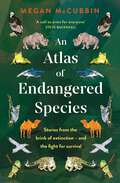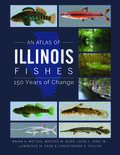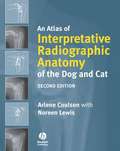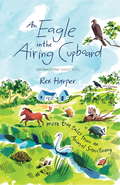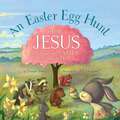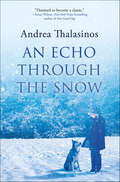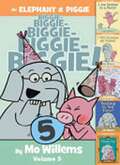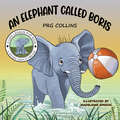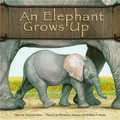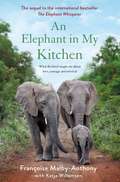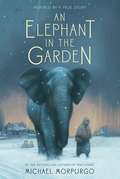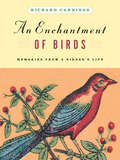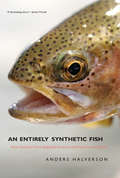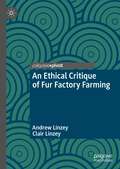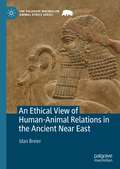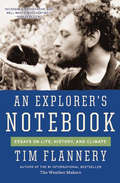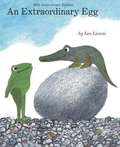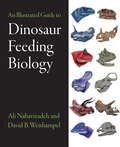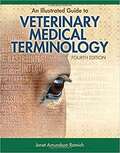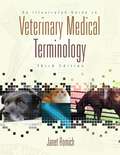- Table View
- List View
An Atlas of Endangered Species
by Megan McCubbin'A call to arms for everyone' Steve BackshallThe diversity of life on earth is astounding, with each species perfectly adapted to its environment. Sharks can navigate the ocean using electromagnetic fields; sloths use algae as camouflage; albatross can fly for hours without beating their wings; and orca pods each have unique cultures and languages. But every hour, three species disappear. Our incredible world is at risk.Megan McCubbin reveals the stories of the scientists, rangers and conservationists who are fighting to save these extraordinary creatures from extinction. An Atlas of Endangered Species shows us that the battle is on for their survival - and we all have a part to play.'Joyful and heartbreaking, an inspiring celebration of some of our planet's most endangered species and those who champion them' - Dave Goulson, author of Silent Earth'A powerful, passionate plea for a wilder future' - Sophie Pavelle, author of Forget Me Not
An Atlas of Illinois Fishes: 150 Years of Change
by Brooks M. Burr Brian A. Metzke Leon C. Hinz Jr. Lawrence M. Page Christopher A. TaylorLake Michigan, winding creeks, sprawling swamps, and one of the world’s great rivers--Illinois’s variety of aquatic habitats makes the Prairie State home to a diverse array of fishes. The first book of its kind in over forty years, An Atlas of Illinois Fishes is a combination of nature guide and natural history. It provides readers with an authoritative resource based on the extensive biological data collected by scientists since the mid-1850s. Each of the entries on Illinois’s 217 current and extirpated fish species offers one or more color photographs; maps depicting distributions at three time periods; descriptions of identifying features; notes on habitat preference; and comments on distribution. In addition, the authors provide a pictorial key for identifying Illinois fishes. Scientifically up-to-date and illustrated with over 240 color photos, An Atlas of Illinois Fishes is a benchmark in the study of Illinois’s ever-changing fish communities and the habitats that support them.
An Atlas of Interpretative Radiographic Anatomy of the Dog and Cat
by Arlene CoulsonThis is the definitive reference for the small animal practitioner to normal radiographic anatomy of the cat and dog. With over forty years of experience between them, the authors have produced an invaluable reference atlas for the veterinary practitioner. The book is suitable for the general and referral based practitioner, undergraduate or postgraduate veterinary surgeon. Over 550 radiographic images analysed and explained More than 50 new figures added, with the quality of existing images enhanced Revised contents and page headers for easy-reference Clear informative line drawings to trace radiographic shadows and schematic drawings of underlying structures not seen in plain radiographs.
An Eagle Named Freedom: My True Story of a Remarkable Friendship
by Jeff Guidry“A hauntingly beautiful story of rescue and rehabilitation….[A] gorgeous tale of redemption.”—Susan Richards, New York Times bestselling author of Chosen by a Horse“I could not put this book down.”—Stacey O'Brien, New York Times bestselling author of Wesley the OwlFrom the moment Jeff Guidry saw the emaciated baby eagle with broken wings, his life was changed. For weeks he and the staff at Sarvey Wildlife Care Center tended to the grievously injured bird. Miraculously, she recovered, and Jeff, a center volunteer, became her devoted caretaker.Though Freedom would never fly, she had Jeff as her wings. And after Jeff was diagnosed with stage 3 non-Hodgkin's lymphoma in 2000, Freedom returned his gift. Between sessions of debilitating chemotherapy, Jeff went back to Sarvey and began taking Freedom for walks that soothed his spirit and gave him the strength to fight. A tender tale of hope, love, trust, and life, this moving true story is an affirmation of the spiritual connection that humans and animals share.
An Eagle in the Airing Cupboard
by Rex HarperAN EAGLE IN THE AIRING CUPBOARD picks up where Rex Harpers first book, AN OTTER ON THE AGA, left off. It follows the fortunes of the Cornish RSPCA centre through one of its most testing twelve months. Once more it is a mixture of funny, touching and sometimes moving animal stories. And once more it features a cast of unforgettable characters, like Alfie and Blue, two hideously mistreated greyhounds that are rehabilitated at the farm, as well as the return of old favourites from Rex's first book, including his loyal dog Moss. Throughout, Rex evokes the sights, smells, sounds and spirit of the Cornish countryside in all its timeless beauty. He also encounters sickening cases of animal cruelty committed by humans unfit to care for any living thing. Funny, warm and evocative, it is a book that is, once more, set to melt and occasionally break the hearts of animal lovers everywhere.
An Easter Egg Hunt for Jesus: God Gave Us Easter to Celebrate His Life (Forest of Faith Books)
by Susan JonesThe perfect book for young boys and girls to celebreate the Easter holiday, learning the meaning of Easter and the love of Jesus through a story of lovable forest animals A quiet forest wakes up from its winter sleep. Buds blossom and trees stretch their branches—spring is here! All the animals are excited for the season of rebirth, because it means Easter is soon to come! Little Bunny and his friends get ready for the special and important day with an Easter egg hunt. But when Little Bunny makes a mistake that makes him think he&’s ruined all the fun, his friends and family come together to help him understand the meaning of Easter—a celebration of Jesus's resurrection and the new life He offers us. An Easter Egg Hunt for Jesus features the same adorable forest creatures met in the heartwarming Christmas storybooks, A Birthday Party for Jesus and Everyone Is Invited to Christmas. Beautifully illustrated by Lee Holland, this picture book will offer young children a fun, relatable story of a little rabbit who makes a mistake and learns how disappointment can transform into hope.
An Echo Through the Snow: A Novel
by Andrea ThalasinosA Wisconsin woman embarks on a transformative journey when she rescues a neglected Siberian husky in this inspiring debut novel.Rosalie MacKenzie is headed nowhere until she sees Smokey, a Siberian husky suffering from neglect. Rosalie finds the courage to rescue the dog, and—united by the bond of love that forms between them—they save each other.Soon Rosalie and Smokey are immersed in the world of competitive dogsled racing. Days are filled with training runs, the stark beauty of rural Wisconsin, and the whoosh of runners on snow. Rosalie discovers that behind the modern sport lies a tragic history: the heartbreaking story of the Chukchi people of Siberia. When Stalin’s Red Army displaced the Chukchi in 1929, many were killed and others lost their homes and their beloved Guardians—the huskies that were the soul and livelihood of their people.Alternating between past and present, telling of a struggling Chukchi family and a young woman discovering herself, An Echo Through the Snow takes readers on a gripping, profound, and uplifting dogsled ride to the Iditarod and beyond, on a journey of survival and healing.“A sensitive and engaging story which beautifully illustrates the ancient human/canine bond. [Thalsinos’s] rendering of the little-known story of the Chukchi people of Siberia is heart-wrenching and uplifting at the same time. The interwoven stories of Jeaantaa and Rosalie and the dogs that mean so much to them is destined to become a classic.” —Susan Wilson, New York Times–bestselling author of One Good Dog
An Edwardian Bestiary: 87 Color Plates
by Jeff A. Menges Maurice Detmold Edward J. DetmoldA prodigiously talented pair of English twins, the Detmold brothers shared an intense passion for drawing and observing animals. As young children, they began sketching at the Zoological Gardens in London, displayed their work at the Royal Academy by the time they were 13, and published their first book of illustrations soon after. The British art world recognized their unique gift immediately and saw them as a single creative soul residing in two bodies. Their exquisite etchings, watercolors, and pen and ink drawings, rendered in the Japanese style, are remarkable for their fine detail and vivid coloration.This glorious collection of illustrations ranges from the Detmolds' 1899 debut, Pictures from Birdland, to a 1925 edition of the exotic Arabian Nights. Other selections include curious creatures great and small from Aesop's Fables and Fabre's Book of Insects. You'll encounter a meticulously rendered menagerie that includes a slithering python and fierce tiger from The Jungle Book, a vain jackdaw with beautiful plumage, a glistening lizard and butterfly in a garden, a lace-winged praying mantis, and so much more. Collectors of fine art and beautiful books, as well as animal lovers, will treasure this distinctive art from the Golden Age of book illustration.
An Elephant And Piggie Biggie!: Volume 5 (An Elephant And Piggie Book)
by Mo WillemsFor the fifth time ever, best friends Elephant and Piggie have five BIGGIE adventures in one book! From award-winning, best-selling author and illustrator Mo Willems, this BIGGIE bind-up of Elephant & Piggie adventures will make readers want to celebrate! This bind-up includes the titles: I Am Invited to a Party!; I Will Surprise My Friend!; Happy Pig Day!; Waiting IsNot Easy!; and The Thank You Book.
An Elephant Called Boris
by Prg CollinsBoris didn’t know the dangers of taking drugs, and he never really thought about drugs until some people suggested he try the fruit of the Marula tree which can cause you to do strange things if you eat it. They made him feel like a weak elephant if he didn’t try it, so Boris said ‘Okay’ even though he didn’t really want to do it! What happened to Boris after he ate it was terrible. Find out what strange and wrongs things he did and how he felt! And learn the lesson from Boris, that taking drugs, no matter who tried to talk you into it, is wrong and dangerous for you!
An Elephant Grows Up (Wild Animals)
by Anastasia SuenDescribes the development of elephants from infancy to adulthood, as they grow up under the hot African sun.
An Elephant in My Kitchen: What the Herd Taught Me About Love, Courage and Survival (Elephant Whisperer #2)
by Françoise Malby-Anthony Katja WillemsenTHE INTERNATIONAL BESTSELLER"Malby-Anthony offers a book of great inspiration and wide appeal to nature-loving readers." —Publishers WeeklyA heart-warming sequel to the international bestseller The Elephant Whisperer, by Lawrence Anthony's wife Françoise Malby-Anthony. A chic Parisienne, Françoise never expected to find herself living on a South African game reserve. But then she fell in love with conservationist Lawrence Anthony and everything changed. After Lawrence’s death, Françoise faced the daunting responsibility of running Thula Thula without him. Poachers attacked their rhinos, their security team wouldn’t take orders from a woman and the authorities were threatening to cull their beloved elephant family. On top of that, the herd’s feisty new matriarch Frankie didn’t like her.In this heart-warming and moving book, Françoise describes how she fought to protect the herd and to make her dream of building a wildlife rescue center a reality. She found herself caring for a lost baby elephant who turned up at her house, and offering refuge to traumatized orphaned rhinos, and a hippo called Charlie who was scared of water. As she learned to trust herself, she discovered she’d had Frankie wrong all along.Filled with extraordinary animals and the humans who dedicate their lives to saving them, An Elephant in My Kitchen is a captivating and gripping read.
An Elephant in the Garden
by Michael MorpurgoLizzie and Karl’s mother is a zoo keeper; the family has become attached to an orphaned elephant named Marlene, who will be destroyed as a precautionary measure so she and the other animals don’t run wild should the zoo be hit by bombs. The family persuades the zoo director to let Marlene stay in their garden instead. When the city is bombed, the family flees with thousands of others, but how can they walk the same route when they have an elephant in tow, and keep themselves safe? Along the way, they meet Peter, a Canadian navigator who risks his own capture to save the family. As Michael Morpurgo writes in an author’s note, An Elephant in the Garden is inspired by historical truths, and by his admiration for elephants, “the noblest and wisest and most sensitive of all creatures.” Here is a story that brings together an unlikely group of survivors whose faith in kindness and love proves the best weapon of all.
An Enchantment of Birds
by Richard CanningsIn these delightful meditations, biologist and bird lover Richard Cannings weaves stories of his personal encounters with birds into fascinating descriptions of their behavior, anatomy, and evolution. He muses over the meadowlarks' ability to hide their nests so completely that he has seen only two in a lifetime spent searching for them; the trumpeter swan, as picky as a two-year old, devouring potatoes and carrots but turning up its beak at Brussels sprouts; the northern gannet, with its snowy plumage, black wingtips, and startling blue eyes; the little saw-whet owl, which dabbles in bigamy and even trigamy; and more than two dozen other birds. Covering the entire continent, from the cacophony of a seabird colony on the shores of the Atlantic to a symphony of snow geese on the autumn plains to songbird courtship in the alpine tundra of the Rockies, An Enchantment of Birds informs and entertains, in one fell swoop.
An Encyclopedia of Animals (On Our Way to English #Level M)
by Elizabeth MassieWith so many animals in the world, how can we tell the difference between them? One way is to group together animals that have things in common. You will notice that all of the animals in this book have a backbone. You have a backbone, too. It is the bone that runs down your back.
An Entirely Synthetic Fish
by Anders HalversonAnders Halverson provides an exhaustively researched and grippingly rendered account of the rainbow trout and why it has become the most commonly stocked and controversial freshwater fish in the United States. Discovered in the remote waters of northern California, rainbow trout have been artificially propagated and distributed for more than 130 years by government officials eager to present Americans with an opportunity to get back to nature by going fishing. Proudly dubbed "an entirely synthetic fish" by fisheries managers, the rainbow trout has been introduced into every state and province in the United States and Canada and to every continent except Antarctica, often with devastating effects on the native fauna. Halverson examines the paradoxes and reveals a range of characters, from nineteenth-century boosters who believed rainbows could be the saviors of democracy to twenty-first-century biologists who now seek to eradicate them from waters around the globe. Ultimately, the story of the rainbow trout is the story of our relationship with the natural world--how it has changed and how it startlingly has not.
An Ethical Critique of Fur Factory Farming (The Palgrave Macmillan Animal Ethics Series)
by Andrew Linzey Clair LinzeyThe fur trade is a multi-million-dollar industry. It is estimated that over 100 million animals are killed in fur farms worldwide annually. This book provides an in-depth analysis of the state of fur factory farming worldwide, and an ethical critique of the main arguments propounded by the fur industry. Consideration is also given to an attempt to justify fur farming through the concept of “Welfur." Andrew Linzey and Clair Linzey argue that from any ethical perspective, fur factory farming fails basic moral tests.
An Ethical View of Human-Animal Relations in the Ancient Near East (The Palgrave Macmillan Animal Ethics Series)
by Idan BreierExploring the earliest literary evidence for human-animal relations, this volume presents and analyzes biblical and Mesopotamian (Sumerian, Assyrian, and Babylonian) sources from the third millennium BCE through to the consolidation of the biblical literature in the first millennium BCE. Key Features:Provides the first comprehensive study of these texts from an ethical perspective.Examines proverbs, popular aphorisms, myths, epic literature, wisdom literature, historiography, prophecy, and law codes.Applies methodology from current contemporary biblical and ancient Near Eastern scholarship and human-animal ethics, thereby raising new questions that lead to fresh insights.An Ethical View of Human Animal-Relations in the Ancient Near East is essential reading for scholars and graduate students of animal ethics, applied ethics and biblical studies.
An Explorer's Notebook: Essays on Life, History, and Climate
by Tim FlanneryBest known today for The Weather Makers, his #1 international bestseller, Tim Flannery is one of the world’s most influential scientists, a foremost expert on climate change credited with discovering more species than Charles Darwin. But Flannery didn’t come to his knowledge overnight. With its selection of exhilarating essays and articles written over the past 25 years, An Explorer’s Notebook charts the evolution of a young scientist doing fieldwork in remote locations to the major thinker who has changed the way we think about global warming.In over thirty pieces, Flannery writes about his journeys in the jungles of New Guinea and Indonesia, about the extraordinary people he met and the species he discovered. He writes about matters as wide-ranging as love, insects, population, water and the stresses we put on the environment. He shows us how we can better predict our future by understanding the profound history of life on Earth. And he chronicles the seismic shift in the world’s attitude toward climate change. An Explorer’s Notebook is classic Flannery-wide-ranging, eye-opening science, conveyed with richly detailed storytelling."Tim Flannery is in the league of all-time great explorers like Dr. David Livingstone.”-Sir David Attenborough
An Extraordinary Egg
by Leo LionniWhile taking a walk, three frogs discover what they believe to be a chicken egg and eagerly wait for it to hatch. When a scaly, four-legged creature with a long snoutful of teeth emerges a few days later, the frogs are still convinced it's a chicken and are thrilled to have a new friend. Soon the frogs and "chicken" are inseparable, at least until the day "chicken" finds and returns to her mother...an enormous "hen" who looks suspiciously like an alligator! "An eggstraordinary treat from a master storyteller."--School Library Journal."Just the thing to lighten up a picture-book hour."--Kirkus.
An Illustrated Guide to Dinosaur Feeding Biology
by David B. Weishampel Ali NabavizadehThis beautifully illustrated exploration of the diversity, anatomy, and evolution of dinosaur feeding adaptations is the first and only in-depth look at this crucial aspect of paleoecology.In An Illustrated Guide to Dinosaur Feeding Biology, experts Ali Nabavizadeh and David B. Weishampel bring dinosaurs to life on the page by exploring and illustrating their feeding adaptations. Whether dinosaurs were carnivorous, herbivorous, or omnivorous, their evolution produced a multitude of specialized adaptations that helped shape their ecologies. Dinosaur skulls show a variety of bone and joint specializations ideal for withstanding stresses and strains induced by high bite forces with strong jaw musculature. The bladed, steak-knife dentition of many carnivorous dinosaurs was well-suited for slicing meat and crushing bones, while the leaf-shaped, sometimes tightly packed dentition of many herbivorous dinosaurs was ideal for grinding up a variety of plant material.The first book of its kind, An Illustrated Guide to Dinosaur Feeding Biology is a synthesis of over a century of dinosaur feeding biology research, from the earliest hypotheses in the 1800s to today's studies using advanced techniques. Intended for both researchers and dinosaur enthusiasts alike, this book discusses functional morphological studies highlighting comparative anatomy, tooth wear, muscle reconstruction, and biomechanical analysis using modeling techniques like finite element analysis and multibody dynamics analysis. In addition to the feeding apparatus, Nabavizadeh and Weishampel explore postcranial adaptations and discuss the evolution of dinosaurs and their paleoecology more broadly. Integrating these various factors improves our understanding of dinosaurs as the living beings they were in their ecosystems millions of years ago and ultimately expands our knowledge and perspective of today's ecosystems by framing them in a broader evolutionary context.
An Illustrated Guide to Veterinary Medical Terminology
by Janet Amundson RomichProviding the ultimate terminology reference for veterinary assistants and technicians, AN ILLUSTRATED GUIDE TO VETERINARY MEDICAL TERMINOLOGY, 4e provides an engaging, systematic approach to learning medical terms and understanding basic principles of veterinary medicine. This user-friendly textbook delivers a unique pedagogical presentation that makes it a comprehensive learning resource. Focusing on how medical terms are formed, analyzed, and defined, the text discusses anatomical landmarks, the positioning of animals, and the relationships between body parts. It also introduces terms used in the animal industry. Case studies illustrate how medical terminology is experienced in real-world practice, and an audio wordlist enables readers to hear the terms they are learning.
An Illustrated Guide to Veterinary Medical Terminology (3rd edition)
by Janet Amundson RomichA systematic approach to breaking down the parts of medical terms is used, allowing readers to grasp basic medical concepts and apply critical thinking skills when faced with new and unfamiliar medical terminology.
An Illustrated Handbook of Horse and Pony Care
by Tim Hawcroft Jane KiddAnyone who owns a horse or who works with horses and ponies knows the importance of ensuring that they are healthy, well-behaved, and well-disciplined. This is more easily said than done; like humans, horses are individuals and they often have specific care and management problems. Some of these problems are inherent in their physiological makeup; others may be man-made because of the environment provided. Still others may be caused by accident or by infection. The Illustrated Encyclopedia of Horse and Pony Care is an authoritative and practical guide to all aspects of looking after the horse and pony. It is designed to meet the needs and stimulate the interests of anyone involved with horses and ponies - from parents buying their child's first pony to breeders and trainers. The book is divided into four main sections, beginning with Buying a Horse. Each aspect for consideration in this section is presented on a double- page spread including conformation, temperament, and identification. Color photographs are combined with superb color paintings to provide a thorough guide to colors and natural markings. The second section, Handling the Horse, includes step-by-step instructions and accompanying photographs on how to approach, catch, and lead a horse; various methods of restraint for adults and foals; how to transport your horse by road, rail, sea, or air. There are beautifully detailed illustrations showing the various types of saddles and bridles, sequences of color photographs showing the correct way to put on the tack, and useful advice on how to care for this valuable equipment. The next section which is the main focus of the book, concerns the healthy horse. Guidelines are set out for daily care, including feeding, grooming, and exercise with important points presented in charts for quick and easy reference. Periodic care includes worming and teeth care, with chapters on shoeing and vaccination. Vital first-aid techniques are explained with clear, easy-to-follow instructions. One of the most important features of the book is its coverage of specific health problems. Drawing on his extensive knowledge and sound veterinary practice, Tim Hawcroft has illustrated and enumerated the most common and easily-recognizable illnesses and accidents that a horse may suffer from. These diseases and problems are arranged from A-to-Z with details of signs, symptoms, and treatment given for each ailment. The fourth and final section of the book discusses breeding. There are chapters on selection and management of the stallion and mare; preparation for the service; pregnancy diagnosis including details of the latest ultrasound techniques; a series of color photographs illustrating the various stages of foaling; advice on how to care for the mare after foaling; common diseases and problems of foals with full details of treatment; and, finally, specific care requirements of youngstock.
